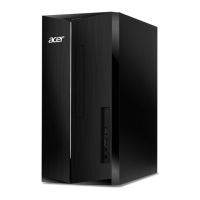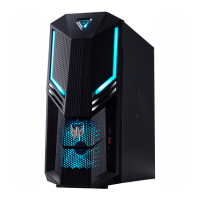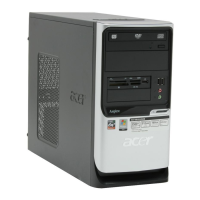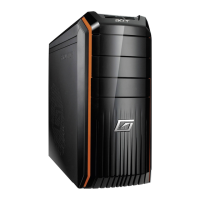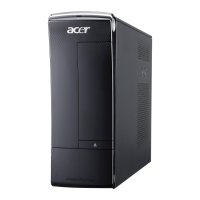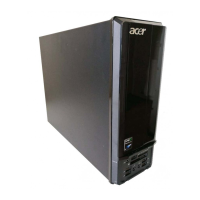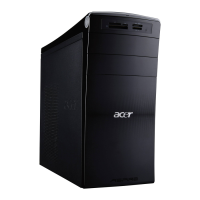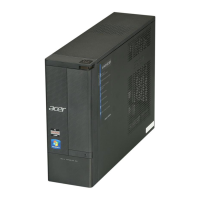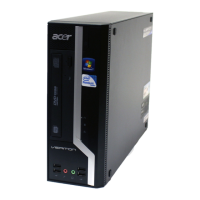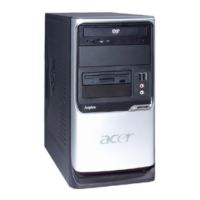Do you have a question about the Acer imedia S3811 and is the answer not in the manual?
Provides a record of updates made to the imedia S3811 series guide.
Contains copyright information and a disclaimer regarding changes and warranties.
Explains the meaning of symbols and text conventions used throughout the manual.
General information and important notes before using the product and its guide.
Overview of the H57D02 motherboard, its performance, and compatibility.
Details on operating system, processor, chipset, memory, LAN, audio, and expansion.
Lists available ports like PS/2, VGA, HDMI, USB, LAN, and audio jacks.
Information about AMI BIOS features for system configuration.
Physical specifications of the computer.
Detailed breakdown of motherboard components with labels and descriptions.
Visual representation of the motherboard's architecture and connections.
Identifies and describes front panel components like USB, audio, and card reader.
Identifies and describes rear panel ports like PS/2, HDMI, USB, LAN, and audio.
Table detailing color-coded audio jack functions for different channel configurations.
Detailed description and labeling of the motherboard's input/output ports.
Introduces basic system peripherals like mouse, keyboard, and speakers.
Information about the optional card reader and supported memory card types.
Details on processor type, socket, speed, and FSB.
Information on BIOS code, version, size, type, and support protocols.
Lists keyboard shortcuts for accessing BIOS setup and boot menu.
Identifies major chipset and controller chips on the motherboard.
Details on memory slots, capacity, type, interface, and module package.
Information on first and second-level cache configurations.
Specifications for video controller, bus, and interface type.
Information on audio controller, type, channel, function, and sampling rate.
Details on IDE controller, SATA connectors, and bootable CD-ROM support.
Information on USB type and number of ports.
Details power management states (S1, S3, S4, S5) and device support.
Explains ACPI functions like Device Standby, Global Standby, and Suspend modes.
Overview of the BIOS Setup Utility, its purpose, and capabilities.
Recommendations for using the Setup Utility for standard configurations and troubleshooting.
Instructions on how to access the BIOS Setup Utility via the DEL key during POST.
Displays the main menu of the BIOS Setup Utility and available options.
Lists the keyboard keys used for navigating and operating the BIOS Setup Utility.
Step-by-step guide for downloading and installing BIOS updates from the manufacturer's website.
Explains how to navigate menus, select options, and understand prompts within the BIOS Setup Utility.
Displays basic system information like processor type, speed, memory, and BIOS version.
Allows viewing and configuring system date, time, and basic hardware settings.
Configuration options for SATA ports, including AHCI mode and S.M.A.R.T. status.
Configures critical timing parameters like EIST, Turbo Boost, XD Bit, and VT.
Sets the order of devices for system boot-up (Hard Disk, CD/DVD, USB, Network).
Defines the boot sequence for hard disk drives.
Defines the boot sequence for optical disk drives.
Defines the boot sequence for removable devices like USB drives.
Defines the boot sequence for network devices.
Configures Num Lock status and USB beep message during startup.
Configures critical timing parameters like EIST, Turbo Boost, XD Bit, and VT.
Configures critical timing parameters like EIST, Turbo Boost, XD Bit, and VT.
Configures onboard devices like SATA, USB, Audio, and LAN controllers.
Configures onboard devices like SATA, USB, Audio, and LAN controllers.
Sets ACPI suspend modes (S1, S3) and wake-up event configurations.
Sets ACPI suspend modes (S1, S3) and wake-up event configurations.
Defines how the system behaves after AC power loss.
Displays critical voltages, temperatures, and fan speeds for system health.
Displays critical voltages, temperatures, and fan speeds for system health.
Configures clock settings for DIMM/PCI/PCIE and Spread Spectrum.
Configures clock settings for DIMM/PCI/PCIE and Spread Spectrum.
Allows setting and changing Supervisor and User passwords for system security.
Allows setting and changing Supervisor and User passwords for system security.
Resets BIOS settings to factory defaults for stability.
Options to save changes and exit or discard changes and exit the BIOS Setup Utility.
Lists necessary tools for disassembling the computer, like grounding strap and screwdrivers.
Precautionary steps before starting the disassembly process, like powering off.
Step-by-step guide for assembling computer components.
Instructions for removing the HDD bracket and front bezel.
Steps for rotating the front bezel and inserting ODD devices.
Steps for installing the motherboard, including CPU and CPU cooler.
Instructions for connecting the CPU fan cable and securing the CPU cooler.
Guide on how to install memory modules into DIMM slots, including a memory install rule table.
Steps for mounting the motherboard and installing the system fan.
Details on securing the system fan and connecting its power cable.
Connecting front panel cables and installing the HDD into its bracket.
Steps for mounting the HDD into the chassis and connecting SATA cables.
Instructions for removing PCI slots and installing a VGA card.
Steps for installing the Power Supply Unit and connecting its power cables.
Shows how to connect power cables for Optical Drive and Hard Disk Drive.
Shows a view of the assembled internal components.
Step-by-step guide for disassembling computer components.
Steps for disconnecting power connectors from the motherboard and components.
Instructions for removing the power supply and HDD, including SATA cable disconnection.
Steps for removing HDD bracket and the HDD itself.
Instructions for removing the VGA card and front panel cables.
Steps for disconnecting and removing the system fan.
Instructions for removing the main board and the rear I/O shield.
Steps for safely removing the RTC battery.
Instructions for removing the CPU cooler and the CPU.
Steps for removing memory modules and reassembling the front bezel.
Instructions for removing the Optical Disk Drive (ODD) and its bracket.
Steps for removing front panel modules and managing cables.
Instructions for removing power switch and HDD LED holder components.
Steps for removing HDD LED housing and front panel modules.
Explains the POST process for system initialization and basic diagnosis.
Lists error messages displayed during POST and their corresponding actions/FRUs.
Provides a list of common error symptoms and their potential causes or FRUs.
Guidance for diagnosing problems when symptoms are not clearly identified.
Details common POST tasks denoted by checkpoint numbers for diagnosis.
Lists POST error messages and recommended actions or FRU replacements.
Lists symptoms related to processor and fan issues and their remedies.
Lists symptoms related to memory issues and their remedies.
Lists symptoms related to hard disk drive failures and their remedies.
Lists symptoms related to CD/DVD-ROM drive failures and their remedies.
Lists symptoms related to RTC and audio issues and their remedies.
Lists symptoms related to modem failures and their remedies.
Lists symptoms related to video and monitor issues and their remedies.
Lists symptoms related to parallel/serial port issues and their remedies.
Lists symptoms related to keyboard issues and their remedies.
Lists symptoms related to power supply failures and their remedies.
Covers other system problems and troubleshooting steps.
Provides a systematic approach to diagnose and isolate unknown hardware issues.
Essential safety precautions to follow when installing the motherboard.
Guidelines for choosing a compatible computer case for the motherboard.
Step-by-step instructions for physically installing the motherboard into a computer case.
Explains how to set motherboard jumpers for correct system configuration.
Details specific jumper settings like CLR_CMOS and ME_ENABLE.
Guides on connecting CPU fan, power supply, case switches, and LEDs to the motherboard.
Provides pinout details for CPU_FAN, SYS_FAN, ATX_POWER, ATX12V, and SPK connectors.
Explains the F_PANEL header, including HDD LED, power/sleep LEDs, reset, and power switches.
Information on connecting optional devices like front panel audio and jumpers.
Cautionary advice and recommendations for installing the CPU and heatsink.
Detailed steps for installing the CPU package into the socket.
Step-by-step guide for installing DDR3 SDRAM memory modules.
Instructions for installing SATA hard drives using SATA cables.
Information on installing expansion cards into PCI Express slots.
General steps for installing add-on cards into expansion slots.
Exploded view of chassis components with a card reader.
Exploded view of chassis components without a card reader.
A list of Field Replaceable Units for the product.
Provides a record of updates made to the imedia S3811 series guide.
Contains copyright information and a disclaimer regarding changes and warranties.
Explains the meaning of symbols and text conventions used throughout the manual.
General information and important notes before using the product and its guide.
Overview of the H57D02 motherboard, its performance, and compatibility.
Details on operating system, processor, chipset, memory, LAN, audio, and expansion.
Lists available ports like PS/2, VGA, HDMI, USB, LAN, and audio jacks.
Information about AMI BIOS features for system configuration.
Physical specifications of the computer.
Detailed breakdown of motherboard components with labels and descriptions.
Visual representation of the motherboard's architecture and connections.
Identifies and describes front panel components like USB, audio, and card reader.
Identifies and describes rear panel ports like PS/2, HDMI, USB, LAN, and audio.
Table detailing color-coded audio jack functions for different channel configurations.
Detailed description and labeling of the motherboard's input/output ports.
Introduces basic system peripherals like mouse, keyboard, and speakers.
Information about the optional card reader and supported memory card types.
Details on processor type, socket, speed, and FSB.
Information on BIOS code, version, size, type, and support protocols.
Lists keyboard shortcuts for accessing BIOS setup and boot menu.
Identifies major chipset and controller chips on the motherboard.
Details on memory slots, capacity, type, interface, and module package.
Information on first and second-level cache configurations.
Specifications for video controller, bus, and interface type.
Information on audio controller, type, channel, function, and sampling rate.
Details on IDE controller, SATA connectors, and bootable CD-ROM support.
Information on USB type and number of ports.
Details power management states (S1, S3, S4, S5) and device support.
Explains ACPI functions like Device Standby, Global Standby, and Suspend modes.
Overview of the BIOS Setup Utility, its purpose, and capabilities.
Recommendations for using the Setup Utility for standard configurations and troubleshooting.
Instructions on how to access the BIOS Setup Utility via the DEL key during POST.
Displays the main menu of the BIOS Setup Utility and available options.
Lists the keyboard keys used for navigating and operating the BIOS Setup Utility.
Step-by-step guide for downloading and installing BIOS updates from the manufacturer's website.
Explains how to navigate menus, select options, and understand prompts within the BIOS Setup Utility.
Displays basic system information like processor type, speed, memory, and BIOS version.
Allows viewing and configuring system date, time, and basic hardware settings.
Configuration options for SATA ports, including AHCI mode and S.M.A.R.T. status.
Configures critical timing parameters like EIST, Turbo Boost, XD Bit, and VT.
Sets the order of devices for system boot-up (Hard Disk, CD/DVD, USB, Network).
Defines the boot sequence for hard disk drives.
Defines the boot sequence for optical disk drives.
Defines the boot sequence for removable devices like USB drives.
Defines the boot sequence for network devices.
Configures Num Lock status and USB beep message during startup.
Configures critical timing parameters like EIST, Turbo Boost, XD Bit, and VT.
Configures critical timing parameters like EIST, Turbo Boost, XD Bit, and VT.
Configures onboard devices like SATA, USB, Audio, and LAN controllers.
Configures onboard devices like SATA, USB, Audio, and LAN controllers.
Sets ACPI suspend modes (S1, S3) and wake-up event configurations.
Sets ACPI suspend modes (S1, S3) and wake-up event configurations.
Defines how the system behaves after AC power loss.
Displays critical voltages, temperatures, and fan speeds for system health.
Displays critical voltages, temperatures, and fan speeds for system health.
Configures clock settings for DIMM/PCI/PCIE and Spread Spectrum.
Configures clock settings for DIMM/PCI/PCIE and Spread Spectrum.
Allows setting and changing Supervisor and User passwords for system security.
Allows setting and changing Supervisor and User passwords for system security.
Resets BIOS settings to factory defaults for stability.
Options to save changes and exit or discard changes and exit the BIOS Setup Utility.
Lists necessary tools for disassembling the computer, like grounding strap and screwdrivers.
Precautionary steps before starting the disassembly process, like powering off.
Step-by-step guide for assembling computer components.
Instructions for removing the HDD bracket and front bezel.
Steps for rotating the front bezel and inserting ODD devices.
Steps for installing the motherboard, including CPU and CPU cooler.
Instructions for connecting the CPU fan cable and securing the CPU cooler.
Guide on how to install memory modules into DIMM slots, including a memory install rule table.
Steps for mounting the motherboard and installing the system fan.
Details on securing the system fan and connecting its power cable.
Connecting front panel cables and installing the HDD into its bracket.
Steps for mounting the HDD into the chassis and connecting SATA cables.
Instructions for removing PCI slots and installing a VGA card.
Steps for installing the Power Supply Unit and connecting its power cables.
Shows how to connect power cables for Optical Drive and Hard Disk Drive.
Shows a view of the assembled internal components.
Step-by-step guide for disassembling computer components.
Steps for disconnecting power connectors from the motherboard and components.
Instructions for removing the power supply and HDD, including SATA cable disconnection.
Steps for removing HDD bracket and the HDD itself.
Instructions for removing the VGA card and front panel cables.
Steps for disconnecting and removing the system fan.
Instructions for removing the main board and the rear I/O shield.
Steps for safely removing the RTC battery.
Instructions for removing the CPU cooler and the CPU.
Steps for removing memory modules and reassembling the front bezel.
Instructions for removing the Optical Disk Drive (ODD) and its bracket.
Steps for removing front panel modules and managing cables.
Instructions for removing power switch and HDD LED holder components.
Steps for removing HDD LED housing and front panel modules.
Explains the POST process for system initialization and basic diagnosis.
Lists error messages displayed during POST and their corresponding actions/FRUs.
Provides a list of common error symptoms and their potential causes or FRUs.
Guidance for diagnosing problems when symptoms are not clearly identified.
Details common POST tasks denoted by checkpoint numbers for diagnosis.
Lists POST error messages and recommended actions or FRU replacements.
Lists symptoms related to processor and fan issues and their remedies.
Lists symptoms related to memory issues and their remedies.
Lists symptoms related to hard disk drive failures and their remedies.
Lists symptoms related to CD/DVD-ROM drive failures and their remedies.
Lists symptoms related to RTC and audio issues and their remedies.
Lists symptoms related to modem failures and their remedies.
Lists symptoms related to video and monitor issues and their remedies.
Lists symptoms related to parallel/serial port issues and their remedies.
Lists symptoms related to keyboard issues and their remedies.
Lists symptoms related to power supply failures and their remedies.
Covers other system problems and troubleshooting steps.
Provides a systematic approach to diagnose and isolate unknown hardware issues.
Essential safety precautions to follow when installing the motherboard.
Guidelines for choosing a compatible computer case for the motherboard.
Step-by-step instructions for physically installing the motherboard into a computer case.
Explains how to set motherboard jumpers for correct system configuration.
Details specific jumper settings like CLR_CMOS and ME_ENABLE.
Guides on connecting CPU fan, power supply, case switches, and LEDs to the motherboard.
Provides pinout details for CPU_FAN, SYS_FAN, ATX_POWER, ATX12V, and SPK connectors.
Explains the F_PANEL header, including HDD LED, power/sleep LEDs, reset, and power switches.
Information on connecting optional devices like front panel audio and jumpers.
Cautionary advice and recommendations for installing the CPU and heatsink.
Detailed steps for installing the CPU package into the socket.
Step-by-step guide for installing DDR3 SDRAM memory modules.
Instructions for installing SATA hard drives using SATA cables.
Information on installing expansion cards into PCI Express slots.
General steps for installing add-on cards into expansion slots.
Exploded view of chassis components with a card reader.
Exploded view of chassis components without a card reader.
A list of Field Replaceable Units for the product.
| Operating System | Windows 7 Home Premium |
|---|---|
| Chipset | Intel H57 |
| Memory | DDR3 |
| Graphics | Intel HD Graphics |
| Optical Drive | DVD Super Multi |
| Audio | High-definition audio |
| Networking | Gigabit Ethernet |
| Ports | USB 2.0, HDMI, VGA, Ethernet, audio in/out |
